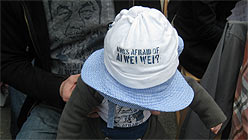I was about 10 minutes late. The Cherry Blossom Festival was happening at the same time and there was a lot of traffic resulting from the parade — confusingly, the Chinese Consulate is located in the Japantown area of San Francisco. As I had walked out the door, my husband quipped about how I was taking a folding chair that had been made in China to protest in front of the Chinese Consulate. It seemed, in itself, a fitting demonstration against the detention of internationally acclaimed artist and iconoclast Ai Weiwei.
Chinese officials in Beijing took the artist into custody on April 3 and he has not been heard from since. His computers and papers have been seized from his studio. I signed a petition for his release initiated by the Solomon R. Guggenheim Foundation — when I signed it online last week, I was number 700 something, but now it numbers more than 90,000 signatures. (Sign the petition here.) Yesterday’s demonstration originated as a suggestion on Facebook by curator Steven Holmes and was then put into action by Creative Time, an organization that advocates for political art in public space. At 1pm hundreds of people gathered at Chinese embassies and consulates all over the world in an international show of solidarity for the artist. It was suggested that demonstrators bring a chair to reference Weiwei’s installation of 1001 chairs, titled “Fairytale,” in Kassel, Germany in 2007.
I parked about four blocks away from the site and walked up a leafy tree-lined street, noticing for the first time that it was a blustery spring day with a slight chill in the air. The demonstrators lined the sidewalk in front of the consulate in a very orderly fashion, organized in rows like outdoor pews. All manner of chairs had been put to service: aluminum lawn chairs and heavy wood chairs were intermixed with those collapsible canvas beach chairs with built in cup holders.
I recognized a few artists, including Enrique Chagoya, Kara Maria, and Cheryl Meeker. Courtney Fink, the executive director of Southern Exposure sat holding a sign that demanded Ai Weiwei’s release written in English and Chinese. I soon learned that the sign had been designed by artist Christine Wong Yap and distributed via the Internet. Art dealer Jack Fischer sat near the closed doors of the Consulate. Along the back row, a man with a cane sat holding a large laminated portrait of Ai — I overheard art dealer Cheryl Haines mention that this man had been crippled during the ’89 protests in Tiananmen Square. Haines, also the executive director of the For-Site Foundation, has worked with Ai on recent exhibitions in her gallery and in a series of site-specific projects at The Presidio. She was visibly emotional throughout the demonstration, simultaneously working her phone to solicit press attention while tending to those in attendance. Her staff moved through the small crowd constantly taking photographs and video footage, passing out buttons that read “Free Weiwei” and offering water in compostable paper cups.
Another button on offer featured the image of a single sunflower seed — a large platter of sunflower seeds was passed through the crowd, in reference to Ai’s “Sunflower Seeds,” the mountain of 10,000 hand-painted porcelain seeds that sold at Sotheby’s for more than $500,000 in February. The man seated to my left sat with a tiny dog on a leash — he had pinned one of the buttons on the dog’s collar. The man on my right, a British artist named Phil, observed how cold it was and suggested that it might be the beginning of a classic San Francisco summer (read: freezing) before mentioning that they were protesting by the hundreds in London. Further in the crowd of about 50 or 60 people sat a couple with their six-month-old baby boy, Elias. Elias wore a beanie cap that read “Who’s Afraid of Ai Weiwei?” and the whole family had matching custom printed t-shirts. A tremendous amount of documentation took place throughout the event. Dozens of people took pictures, some uploading the images immediately to Facebook and Twitter.


